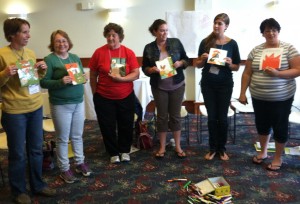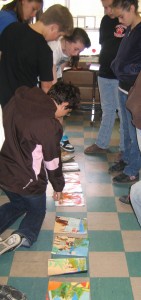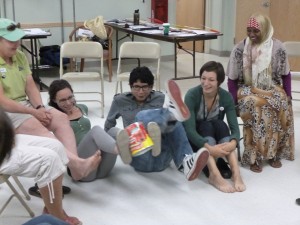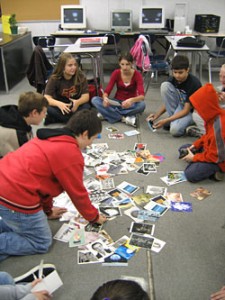Oct 13, 2013 Communication Skills Building Activities Part Two
In yesterday’s post I shared one of my favorite activities for jumpstarting reflection and conversation with groups about communication and the pitfalls of miscommunication called “Telegraph.” Others that I use for this purpose are “Zoom,” “Tin Can Pass,” and “Communication Break Down.”
Zoom
 I wrote about Zoom in my September 2012 post as an example of using sequence based activities to combine problem-solving with academic content review and formative assessment (see September 2012 for these academic variations including “Layers of the Atmosphere Line Up”). I include it again here because it is one of the most effective methods for initiating reflection on group communication that I have come across.
I wrote about Zoom in my September 2012 post as an example of using sequence based activities to combine problem-solving with academic content review and formative assessment (see September 2012 for these academic variations including “Layers of the Atmosphere Line Up”). I include it again here because it is one of the most effective methods for initiating reflection on group communication that I have come across.
 Zoom is a compelling picture book illustrated by artist Istvan Banyai with single sided illustrations that zoom out from a picture of a rooster’s comb through a series of sequences ending with the planet earth seen from outer space. Over the past decade or so it has become a very popular tool used by many in the team-building field as a group problem-solving challenge. The book is taken apart, and the pages are used for the challenge.
Zoom is a compelling picture book illustrated by artist Istvan Banyai with single sided illustrations that zoom out from a picture of a rooster’s comb through a series of sequences ending with the planet earth seen from outer space. Over the past decade or so it has become a very popular tool used by many in the team-building field as a group problem-solving challenge. The book is taken apart, and the pages are used for the challenge.
Though there are probably as many variations as there are facilitators, my favorite way to use the book is to:
1) hand a page of the Zoom book to each group member;
2) explain that the page cannot be shown to anyone else, but participants can talk about and describe the picture to others, and
3) challenge the group members to put themselves in order of their pictures without showing them.
This activity is an effective tool for facilitating reflection about how groups communicate with each other, varying perspectives, leadership, how they deal with frustration and what roles they take on in the group. When used with school faculty, it can lead to interesting reflections on how teachers often “group” by grade levels or subject areas instead of looking at the bigger picture of school-wide goals. In the business world, the reflective discussion often centers on the roles participants took in the game and how this relates to their roles in the workplace and the lines of communication that exist or need to be improved. With students, the lessons often center on listening to others, making a plan, designating a leader, dealing with frustration and perspective taking. Regardless of the group and setting, it brings to the forefront behaviors and dynamics the group is challenged by, and always leads to rich reflective discussions. Keep this in mind when you try it, and give it the time and reflective process necessary to take advantage of the teachable moments that arise.
References and Resources:
Zoom Istvan Banyai (New York: Viking/Penguin Press, 1995)
Inspired Educator, Inspired Learner
I first learned about using the Zoom book as team-building activity from colleagues Michelle Cummings and Chris Cavert when we co-lead a ACCT conference workshop in 2002. The Wilderdom website has a nice write up of this activity with variations at www.wilderdom.com.
Tin Can Pass
Tin Can Pass is my “go to” introduction to problem-solving activity because it is so elegantly simple to set up, and is a great way to ease a group into problem-solving challenges and team-building focused reflection and conversation. I posted about Tin Can Pass in the Fall 2012 “Back to School” series as a great community building activity for new groups coming together. I am writing about it again here because it is another effective method for sparking meaningful reflection on effective group communication for groups of all kinds – especially when a group reaches the “level three challenge”.
 Directions:
Directions:
• Have the group sit in a circle, (floor, chairs or both, are fine).
• Challenge the group to pass the can around the circle using only their feet (specify that this means below the ankle) without dropping it.
• The activity requires the practice of communication, encouragement, and coordination between group members.
• When the group is successful with “level one” (just passing the can) introduce level two by placing a tennis ball or other prop in the can, which often forces the group to change their strategy.
• Level 3: For an advanced challenge, take the ball out, but have group members close their eyes and pass the can (they can open them when they have passed off the can which allows them to verbally guide others in their group).
Facilitation Notes:
If the can is dropped, consider asking participants to decide what to do or suggest that they send it back one person, or restart right there and continue the activity. Sending the can all the way back to where it started if it is dropped might become too frustrating for some groups. It is important to be aware of the necessary balance between challenge and achievable success experiences.
For larger groups you can divide the group in half and have two circles take on the challenge. Or to keep everyone together use two cans and send one to the left and one to the right which keeps more group members engaged and adds the challenge of crossing the can.
Reference: A more detailed descriptor can be found in Inspired Educator, Inspired Learner. I learned this activity from Karl Rohnke many years ago. My students in Steven’s Point, Wisconsin added the level variations.
 Reflection: I often follow this activity with my Pick-A-Postcard collection or other metaphoric image or object reflection methods. I lay out the collection of postcards and ask the group to agree on one card that best represents what they achieved together in the tin can pass activity.
Reflection: I often follow this activity with my Pick-A-Postcard collection or other metaphoric image or object reflection methods. I lay out the collection of postcards and ask the group to agree on one card that best represents what they achieved together in the tin can pass activity.
This is another communication skills building activity in itself. Participants have the opportunity to practice a deeper aspect of communication – the practice of consensus. This method introduces the group to metaphoric reflection in an engaging way that seems an extension of the challenge instead of just a “follow up” to the engaging challenge (see my recent post on The Power of Using Metaphoric Objects and Images in Reflection.



No Comments